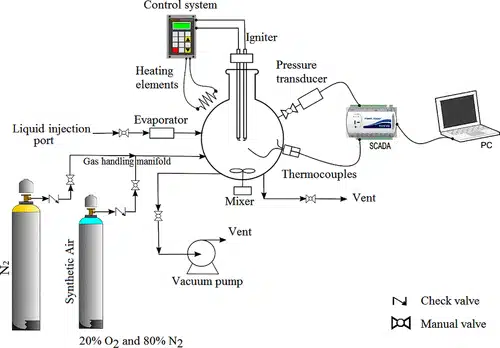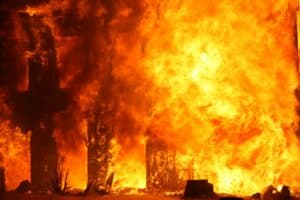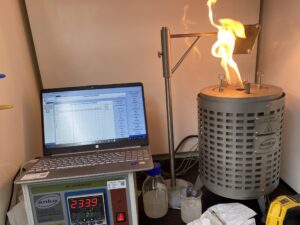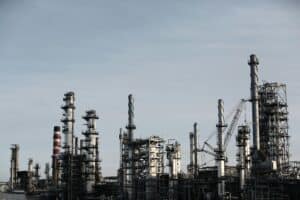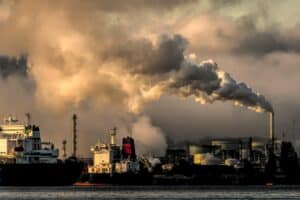We also offer
What is Flammability Limit Testing
Flammability limit testing determines the lower and upper flammable concentration limits of chemicals with sufficient vapor pressure to form flammable mixtures at atmospheric pressure and specific temperatures. This test is typically conducted on volatile liquids and gaseous materials, including refrigerants.
The Lower Explosive Limit (LEL) or Lower Flammable Limit (LFL) is the minimum concentration of a combustible substance in air that can propagate a flame under test conditions. The Upper Explosive Limit (UEL) or Upper Flammable Limit (UFL) is the maximum concentration that can sustain a flame under the same conditions.
Testing Principle and Methodology
For LEL determination, 1% v/v of the material is introduced into a glass vessel under a vacuum. Air is then allowed into the system, and the mixture is blended before an electrical ignition source is applied. Observations are made for flame propagation away from the ignition source. The material concentration is increased in 1% steps until ignition occurs, establishing the LEL.
Once the LEL is determined, a theoretical UEL is calculated. Testing begins at a concentration above this theoretical limit. The same procedure is followed—material is added under vacuum, mixed with air, and ignited. This time, the concentration is decreased in 1% steps until ignition is observed, defining the UEL.
Applicable Standard
-
Refrigerant gases are tested according to ASHRAE 34, using the method described in ASTM E681 – Standard Test Method for Concentration Limits.
-
Specific ignition criteria and air moisture content are considered for accurate results.
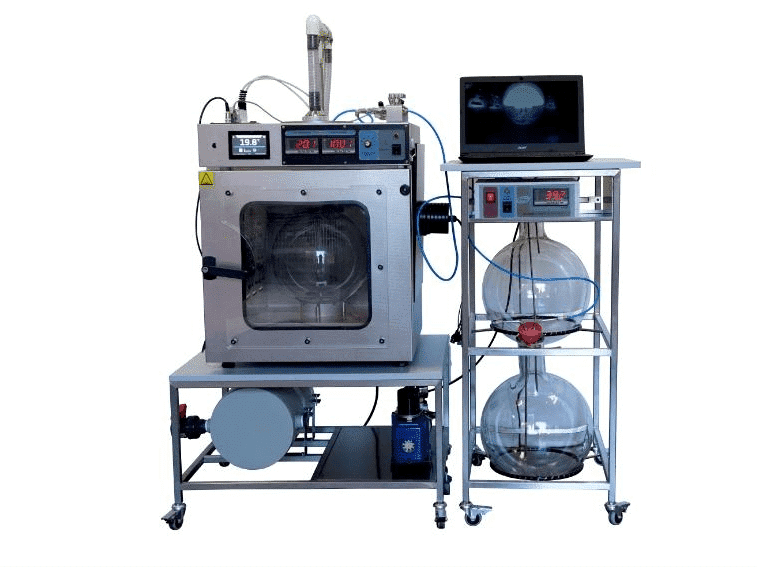
Concentration limits and flammability of refrigerants determination equipment manufactured by Anko
Data Interpretation
Flammability limits depend on test temperature and pressure. This method is limited to an initial pressure of the local ambient or less, with a practical lower pressure limit of about 13 kPa (100 mm Hg). The maximum operating temperature of the test equipment is approximately 150°C.
Understanding these limits helps establish safety guidelines for handling volatile chemicals. They are particularly useful for determining ventilation requirements when working with flammable gases and vapors.
When to Perform Flammability Limit Testing
LFL and UFL testing should be performed under specific conditions to ensure safety, compliance, and risk control:
-
Development of new materials or formulations – to identify flammability characteristics.
-
Post-incident investigation – to determine the cause and prevent recurrence.
-
Environmental or formulation changes – such as temperature, pressure, or composition changes that may alter flammability limits.
Why Choose Prime Process Safety Center
-
Expertise and experience – Our team has extensive knowledge in performing LFL/UFL testing.
-
Advanced equipment – State-of-the-art instruments provide precise, sensitive measurements.
-
Strict protocols – We follow rigorous testing and quality control procedures for consistent results.
- Accreditation: Testing performed in our ISO/IEC 17025:2017 accredited laboratory, ensuring recognized competency and adherence to international quality standards.
-
Data-driven insights – We analyze and interpret your test results, offering valuable recommendations for your application or research.
Prime Process Safety Center delivers accurate, reliable, and defensible data that meets industry and regulatory standards—helping you make informed safety decisions.
FAQ
What are Lower Flammable Limit (LFL) and Upper Flammable Limit (UFL)?
Answer: LFL refers to the minimum concentration of a gas or vapor in air below which the mixture is too lean to ignite. UFL indicates the maximum concentration above which the mixture is too rich to ignite.
Why are LFL and UFL Important in Assessing Flammability?
Answer: Understanding LFL and UFL is crucial for safety as it defines the range of concentrations where gases or vapors can ignite. Operating within this range minimizes fire or explosion risks.
How Are LFL and UFL Determined for Gases and Vapors?
Answer: These limits are determined through laboratory testing using specialized equipment to identify the concentrations at which ignition occurs. Methods include using flame arrestors or ignition sources in controlled environments.
What Factors Affect LFL and UFL of Gases and Vapors?
Answer: Factors such as temperature, pressure, composition, and presence of inert gases impact the flammability limits. Changes in these variables alter the LFL and UFL of substances.
What Are the Safety Implications of Knowing LFL and UFL?
Answer: Understanding these limits helps in establishing safe operating conditions, designing ventilation systems, and implementing safety measures to prevent ignitable atmospheres that could lead to fires or explosions.


